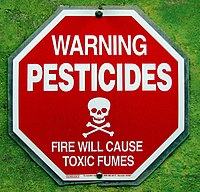
Photo from wikipedia
Pesticide-exposed adolescents may have a higher risk of neurotoxic effects because of their developing brains and bodies. However, only a limited number of studies have addressed this risk among adolescents.… Click to show full abstract
Pesticide-exposed adolescents may have a higher risk of neurotoxic effects because of their developing brains and bodies. However, only a limited number of studies have addressed this risk among adolescents. The aim of this study was to compare neurological outcomes from two cohorts of Egyptian adolescents working as pesticide applicators. In 2005 and 2009, two cohorts of male adolescents working as pesticide applicators for the cotton crop were recruited from Menoufia Governorate, Egypt. The same application schedule and pesticides were used at both times, including both organophosphorus, and pyrethroid compounds. Participants in both cohorts completed three neurobehavioral tests, health and exposure questionnaires, and medical and neurological screening examinations. In addition, blood samples were collected to measure butyryl cholinesterase (BChE) activity. Pesticide applicators in both cohorts reported more neurological symptoms and signs than non-applicators, particularly among participants in the 2005 cohort (OR ranged from 1.18 to 15.3). Except for one test (Trail Making B), there were no significant differences between either applicators or non-applicators of both cohorts on the neurobehavioral outcome measures (p > 0.05). The 2005 cohort showed greater inhibition of serum BChE activity than the 2009 cohort (p < 0.05). In addition, participants with depressed BChE activity showed more symptoms and signs than others without BChE depression (p < 0.05). Our study is the first to examine the consistency of health outcomes associated with pesticide exposure across two cohorts tested at different times from the same geographical region in rural Egypt. This similar pattern of findings across the two cohorts provides strong evidence of the health impact of exposure of adolescents to pesticides.
Journal Title: PLoS ONE
Year Published: 2017
Link to full text (if available)
Share on Social Media: Sign Up to like & get
recommendations!